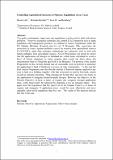Controlling Agricultural Emissions of Nitrates: Regulation versus Taxes

View/
Date
2007Author
Lally, Breda
van Rensburg, Thomas M.
Metadata
Show full item recordUsage
This item's downloads: 1226 (view details)
Recommended Citation
Lally B., Riordan B. & van Rensburg, T. M. (2007) "Controlling Agricultural Emissions of Nitrates: Regulation versus Taxes" (Working Paper No. 0122) Department of Economics, National University of Ireland, Galway.
Abstract
Two policy instruments, input taxes and regulations, can be used to deal with nitrate pollution. However, in practice command and control (CAC) measures such as input regulations and management practices, as outlined in Action Programmes under the EU Nitrates Directive (Council Directive of 12 December 1991 concerning the protection of waters against pollution caused by nitrates from agricultural sources (91/676/EEC), rather than economic instruments, are commonly used to deal with nitrate pollution from agricultural sources. Action Programmes are meant to ensure that the applications of nitrogen to farmland are within limits calculated to avoid a level of nitrate emissions to water supplies that would put them above the concentration limit of 50mg/litre specified in the Directive. The premise of the Action Programmes is that farmers should take all reasonable steps to prevent or minimise the application to land of fertilisers in excess of crop requirements. To this end the Irish Action Programme specifies that the amount of livestock manure applied in any year to land on a holding, together with that deposited on land by livestock, cannot exceed an amount containing 170kg nitrogen per hectare (ha) and also sets limits on the application of inorganic (manufactured) nitrogen. However, the objective of the Nitrates Directive, at least in terms of organic and inorganic nitrogen application rates, could theoretically be achieved by imposing a tax on nitrogen inputs. This paper tests the hypotheses that the objectives of the Nitrates Directive, in terms of organic and inorganic N application rates, would be more effectively and more equitably achieved by regulation, than by a tax. The results of the analysis indicate that this is the case.

